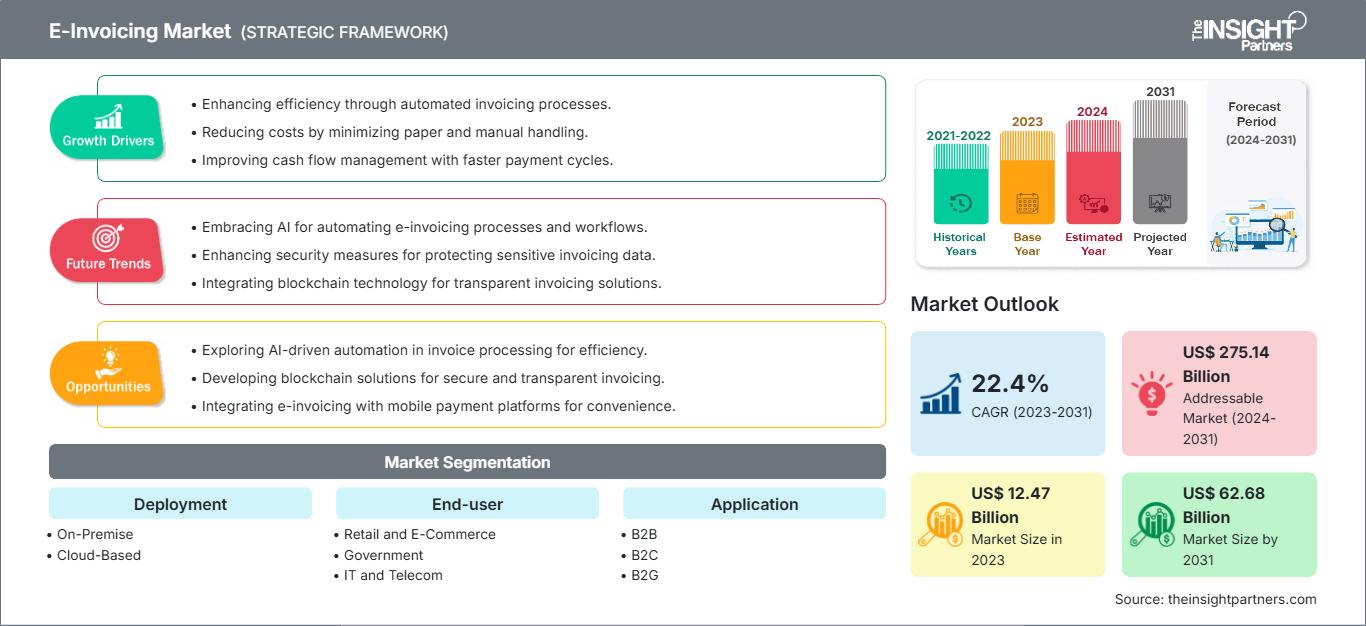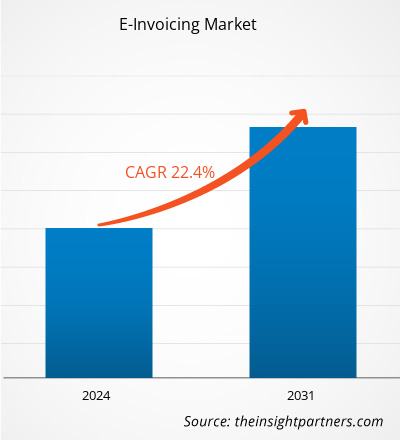Der Markt für elektronische Rechnungsstellung soll von 12,47 Milliarden US-Dollar im Jahr 2023 auf 62,68 Milliarden US-Dollar im Jahr 2031 anwachsen. Für den Markt wird zwischen 2023 und 2031 eine durchschnittliche jährliche Wachstumsrate (CAGR) von 22,4 % erwartet.
Der Bericht enthält Wachstumsaussichten im Lichte der aktuellen Markttrends für elektronische Rechnungsstellung und der treibenden Faktoren, die das Marktwachstum beeinflussen.
Marktanalyse für elektronische Rechnungsstellung
Die steigende Nachfrage nach digitalen Lösungen zur Bekämpfung von Steuerhinterziehung und Finanzbetrug bei Regierungsorganisationen und Steuerbehörden treibt das Wachstum der Vorschriften zur elektronischen Rechnungsstellung in verschiedenen Ländern voran. Verschiedene unterstützende Initiativen von Regierungsorganisationen und Verbänden, wie etwa der European E-Invoicing Service Providers Association (EESPA), CEN, UN/CEFACT, OpenPEPPOL und GS1, spielen eine entscheidende Rolle bei der Entwicklung von Standards/Frameworks/Formaten für die elektronische Rechnungsstellung und deren Einführung in allen Ländern. Was die Einführung der elektronischen Rechnungsstellung angeht, sind Brasilien, Chile und Mexiko die Marktführer, gefolgt von Ländern wie Italien, das die elektronische Rechnungsstellung 2019 verpflichtend einführte. Die erfolgreiche Einführung der elektronischen Rechnungsstellung in diesen Ländern und ihre Vorteile bewegen andere Länder wie Bolivien, Frankreich, Kolumbien, Guatemala, China, Indien, Kirgisistan, Usbekistan, Vietnam, Kroatien, Estland, Serbien und Portugal dazu, die elektronische Rechnungsstellung ebenfalls vorzuschreiben.Marktübersicht zur elektronischen Rechnungsstellung
Die elektronische Rechnungsstellung ist ein wachsender Markt mit zunehmender Akzeptanz in verschiedenen Segmenten wie Business-to-Business (B2B), Business-to-Customer (B2C) und Business-to-Government (B2G). Unter elektronischer Rechnungsstellung versteht man ausschließlich den elektronischen Rechnungsaustausch zwischen Käufern und Lieferanten. Je nach den dort vorherrschenden Vorschriften und der Art der Unternehmen wird die elektronische Rechnungsstellung in den verschiedenen Ländern unterschiedlich definiert. Für den Austausch elektronischer Rechnungen werden branchenübergreifend verschiedene Modelle eingesetzt, darunter das Lieferantendirektmodell, das Käuferdirektmodell, das SaaS/PaaS-Modell, das Netzwerkmodell, das Four Corner-Modell, das Multi-Cloud-Modell und das Hybrid-Cloud-Modell. Unternehmen weltweit tauschen elektronische Rechnungen entweder direkt mit ihren Kunden aus oder nutzen externe Dienstleister. Der zunehmende Trend zur Digitalisierung verschiedener Dokumente zur effizienten Verarbeitung und zur Wahrung der Compliance-Anforderungen fördert den Übergang von manuellen Papierrechnungen zu elektronischen Rechnungen weltweit.Passen Sie diesen Bericht Ihren Anforderungen an
Sie erhalten kostenlos Anpassungen an jedem Bericht, einschließlich Teilen dieses Berichts oder einer Analyse auf Länderebene, eines Excel-Datenpakets sowie tolle Angebote und Rabatte für Start-ups und Universitäten.
Markt für elektronische Rechnungsstellung: Strategische Einblicke

-
Holen Sie sich die wichtigsten Markttrends aus diesem Bericht.Dieses KOSTENLOSE Beispiel umfasst Datenanalysen, die von Markttrends bis hin zu Schätzungen und Prognosen reichen.
Steigende Nachfrage nach Cloud-basierten Lösungen
Cloud Computing wird branchenübergreifend zur treibenden Kraft der digitalen Transformation. Die Nachfrage nach Cloud-basierten Lösungen wächst in Unternehmen aufgrund der Vorteile, die diese Lösungen gegenüber der Bereitstellung vor Ort bieten, in beispiellosem Tempo. Zu den Hauptvorteilen cloudbasierter Lösungen zählen einfache Bereitstellung, Interoperabilität, Kosteneinsparungen, hohe Effizienz und On-Demand-Funktionen. Dienste wie Infrastructure as a Service (IaaS) und Software as a Service (SaaS) verzeichnen ein rasantes Wachstum. Die Akzeptanz cloudbasierter Lösungen variiert jedoch je nach Region und Unternehmen und hängt von Faktoren wie dem regulatorischen Umfeld und der Wettbewerbssituation ab. In kleinen und mittleren Unternehmen ist die Nachfrage nach cloudbasierten Lösungen aufgrund der damit verbundenen Kostenvorteile hoch. Die meisten großen Unternehmen verwenden immer noch On-Premise-Lösungen, da die Implementierung neuer Prozesse in großen Unternehmen und ihren Netzwerken eine komplexe Aufgabe ist und Änderungen der traditionellen Arbeitspraktiken erfordert.Segmentierungsanalyse des E-Invoicing-Marktberichts
Schlüsselsegmente, die zur Ableitung der E-Invoicing-Marktanalyse beigetragen haben, sind Bereitstellung, Endbenutzer, Anwendung und Typ.- Nach Bereitstellungsmodell ist der E-Invoicing-Markt in Cloud und On-Premise segmentiert. Im Jahr 2023 hatte das Cloud-Segment aufgrund von Vorteilen wie einfacher Implementierung, Kosteneinsparungen und betrieblicher Flexibilität einen größeren Marktanteil im Bereich E-Invoicing.
- Basierend auf dem Endnutzer ist der Markt in Einzelhandel und E-Commerce, Regierung, IT und Telekommunikation, BFSI und Sonstige segmentiert. Das Regierungssegment hatte 2023 den größten Marktanteil im Bereich E-Invoicing.
- Basierend auf dem Typ ist der Markt für E-Invoicing in Rechnungen mit und ohne Bestellauftrag segmentiert. Im Jahr 2023 dominierte das Segment der Rechnungen ohne Bestellauftrag den Markt mit einem größeren Marktanteil und wird im Prognosezeitraum voraussichtlich eine höhere durchschnittliche jährliche Wachstumsrate verzeichnen.
- Basierend auf der Anwendung ist der Markt für E-Invoicing in B2B, B2C und B2G unterteilt. Das B2G-Segment hielt den größten Anteil am globalen E-Invoicing-Markt und das B2B-Segment wird im Prognosezeitraum voraussichtlich das am schnellsten wachsende Segment sein.
Geografische Analyse der Marktanteile von E-Invoicing
Der E-Invoicing-Markt ist in fünf große Regionen unterteilt: Nordamerika, Europa, Asien-Pazifik (APAC), Naher Osten und Afrika (MEA) sowie Süd- und Mittelamerika. Nordamerika hielt 2023 den größten Marktanteil im E-Invoicing. Gemessen am Marktanteil belegten Europa, Süd- und Mittelamerika sowie APAC 2023 den zweiten, dritten und vierten Platz. Europa ist ein weiterer wichtiger Markt für E-Invoicing. Vor Kurzem hat Italien als erstes Land in Europa E-Invoicing zur Bekämpfung von Steuerbetrug und Steuerhinterziehung sowie zur Steigerung der Effizienz des Steuersystems vorgeschrieben. Es wird erwartet, dass auch andere europäische Länder dem Beispiel Italiens folgen und die elektronische Rechnungsstellung einführen werden, was dem Markt einen positiven Aufschwung verleihen wird.Markt für elektronische Rechnungsstellung
Markt für elektronische RechnungsstellungDie Analysten von The Insight Partners haben die regionalen Trends und Faktoren, die den E-Invoicing-Markt im Prognosezeitraum beeinflussen, ausführlich erläutert. In diesem Abschnitt werden auch die Marktsegmente und die geografische Lage des E-Invoicing-Marktes in Nordamerika, Europa, im asiatisch-pazifischen Raum, im Nahen Osten und Afrika sowie in Süd- und Mittelamerika erörtert.Umfang des Marktberichts zur elektronischen Rechnungsstellung
| Berichtsattribut | Einzelheiten |
|---|---|
| Marktgröße in 2023 | US$ 12.47 Billion |
| Marktgröße nach 2031 | US$ 62.68 Billion |
| Globale CAGR (2023 - 2031) | 22.4% |
| Historische Daten | 2021-2022 |
| Prognosezeitraum | 2024-2031 |
| Abgedeckte Segmente |
By Bereitstellung
|
| Abgedeckte Regionen und Länder |
Nordamerika
|
| Marktführer und wichtige Unternehmensprofile |
|
Dichte der Marktteilnehmer im Bereich E-Invoicing: Auswirkungen auf die Geschäftsdynamik verstehen
Der E-Invoicing-Markt wächst rasant. Die steigende Nachfrage der Endnutzer ist auf Faktoren wie veränderte Verbraucherpräferenzen, technologische Fortschritte und ein stärkeres Bewusstsein für die Produktvorteile zurückzuführen. Mit der steigenden Nachfrage erweitern Unternehmen ihr Angebot, entwickeln Innovationen, um den Bedürfnissen der Verbraucher gerecht zu werden, und nutzen neue Trends, was das Marktwachstum weiter ankurbelt.

- Holen Sie sich die Markt für elektronische Rechnungsstellung Übersicht der wichtigsten Akteure
Neuigkeiten und aktuelle Entwicklungen im E-Invoicing-Markt
Der E-Invoicing-Markt wird durch die Erhebung qualitativer und quantitativer Daten aus Primär- und Sekundärforschung bewertet, die wichtige Unternehmenspublikationen, Verbandsdaten und Datenbanken umfasst. Im Folgenden finden Sie eine Liste der Entwicklungen im E-Invoicing-Markt:- Im Jahr 2021 gab Coupa Software, einer der führenden Anbieter im Bereich Business Spend Management (BSM), seine offizielle Mitgliedschaft in der E-Invoice Promotion Association (EIPA) bekannt, einer Organisation, die Standard-Spezifikationen für elektronische Rechnungen entwickelt, demonstriert und fördert. (Quelle: Coupa Software, Pressemitteilung)
- Im Jahr 2024 kündigte Basware, ein weltweit führendes Unternehmen im Bereich AP-Automatisierung und Rechnungsverarbeitung, große globale Expansionspläne an, da die Buchungen um 52 % stiegen und sich das Wachstum der wiederkehrenden Einnahmen im Jahr 2023 im Vergleich zum Vorjahr beschleunigte. (Quelle: Sweco AB, Pressemitteilung)
- Im Jahr 2023 unterzeichnete Toyota Boshoku Asia einen Vertrag mit Comarch zur Einführung der elektronischen Rechnungsstellung in Thailand. Comarch wird Toyota Boshoku Asia bei der Einrichtung einer E-Invoicing-Lösung für die Erstellung, Bereitstellung und Speicherung digitaler Dokumente unterstützen, mit digitalen Signaturen für Steuerrechnungen und -belege, die den Bedingungen und Anforderungen der thailändischen Steuerbehörde entsprechen. (Quelle: Toyota Boshoku, Pressemitteilung)
Bericht zum Markt für elektronische Rechnungsstellung: Umfang und Ergebnisse
Der Bericht „Marktgröße und -prognose für elektronische Rechnungsstellung (2022–2030)“ bietet eine detaillierte Marktanalyse in den unten genannten Bereichen:- Marktgröße und -prognose für elektronische Rechnungsstellung auf globaler, regionaler und Länderebene für alle abgedeckten wichtigen Marktsegmente
- Marktdynamik für elektronische Rechnungsstellung wie Treiber, Einschränkungen und wichtige Chancen
- Wichtige zukünftige Trends im Markt für elektronische Rechnungsstellung
- Detaillierte PEST/Porters Five Forces- und SWOT-Analyse
- Globale und regionale Marktanalyse mit wichtigen Markttrends, wichtigen Akteuren, Vorschriften und aktuellen Marktentwicklungen
- Branchenlandschaft und Wettbewerbsanalyse mit Marktkonzentration, Heatmap-Analyse, prominenten Akteuren und aktuellen Entwicklungen im Markt für elektronische Rechnungsstellung
- Detaillierte Unternehmensanalyse Profile
- Historische Analyse (2 Jahre), Basisjahr, Prognose (7 Jahre) mit CAGR
- PEST- und SWOT-Analyse
- Marktgröße Wert/Volumen – Global, Regional, Land
- Branchen- und Wettbewerbslandschaft
- Excel-Datensatz
Aktuelle Berichte
Erfahrungsberichte
Grund zum Kauf
- Fundierte Entscheidungsfindung
- Marktdynamik verstehen
- Wettbewerbsanalyse
- Kundeneinblicke
- Marktprognosen
- Risikominimierung
- Strategische Planung
- Investitionsbegründung
- Identifizierung neuer Märkte
- Verbesserung von Marketingstrategien
- Steigerung der Betriebseffizienz
- Anpassung an regulatorische Trends






















 Kostenlose Probe anfordern für - Markt für elektronische Rechnungsstellung
Kostenlose Probe anfordern für - Markt für elektronische Rechnungsstellung